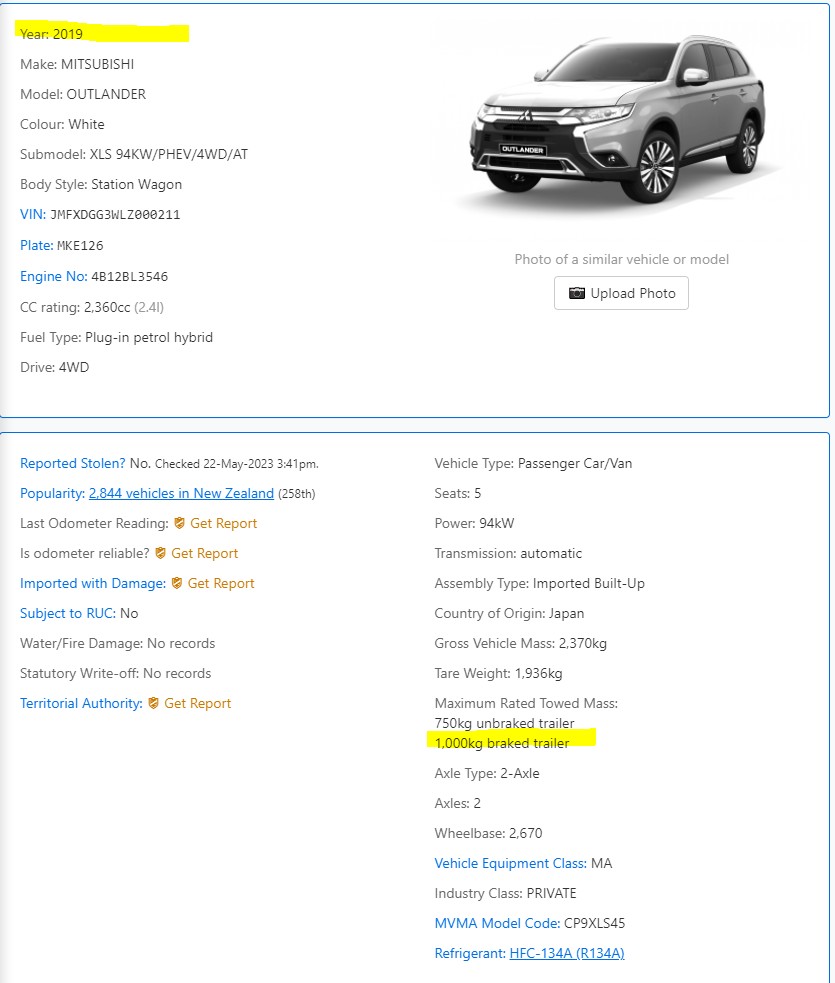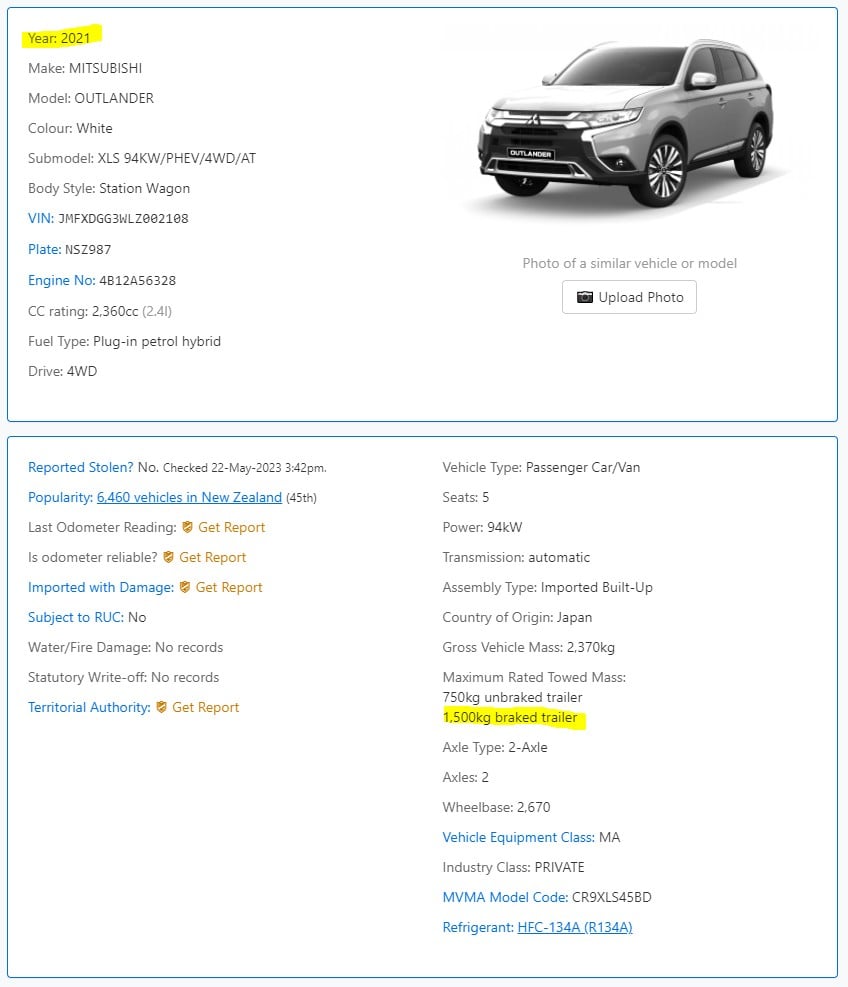Hi All,
Will be in need for a new vehicle soon. Have been eyeing up the Outlander PHEV 2.4litre likely a 2019 or newer model. My question is, are these suitable to tow a caravan of about 1100kg? Any thoughts tips etc would be greatly received.
J
|
|
|
My gut feeling is that it will tow it ok, but you'll be over the rated tow capacity which is only 750kg, both braked and unbraked. You'd want to tow in Charge mode, so that the petrol engine will provide the bulk of the electric power instead of the small battery.
Fuel consumption will be meh.
edit: gut feeling comes from owning one.
contentsofsignaturemaysettleduringshipping
New model has a rated towing capacity of 750/1600kg (unbraked/braked).
“We’ve arranged a society based on science and technology, in which nobody understands anything about science technology. Carl Sagan 1996
I own a 2022 PHEV Outlander. While I can't comment about 1100Kg, I do tow a Jetski.. which I guess is about 600Kg.. and barely notice it is there..
From a mass perspective the Outlander is now is about 2,000kg (not much lighter than the full size Pajero!). So you should be OK, and it's AWD twin motor which must help distribute motor braking.
Does the caravan have good trailer brakes? IIRC correctly the Outlander is running 215 tyres. Absent decent trailer brakes, that's not a lot of rubber to be stopping 1,100kg with. Compare that with the 265s on its big brother the Pajero which is only a few hundred kgs heavier.
In summary, if you have decent trailer brakes and watch how much stuff you cram into the caravan, I think you'll be fine.
Mike
I don't see why you would have any issues. Should tow comparably to similar Soft SUV's (need to be careful not to overload the rear axle etc).
1100kg is quite a bit under the 1500kg tow rating.
Note that the out lander PHEV has a reputation for not being super economical in hybrid mode (around the same as petrol version of the car on the open road), and caravans add a heap of drag, so (as per most other competing SUV's, it will drink a lot of fuel towing).
Probably best to use charge / sustain modes to keep a fairly high state of charge on towing trips that exceed your electric range (use the electric bit at the end of the trip). This is to ensure an ample buffer of power in the battery for the likes of hill climbs, where the car will tortus mode if you do a large hill climb (Every hybrid has a similar mode, when the battery runs completely flat, output will be reduced from Engine + Battery, to engine alone (something like 90kW) in this case, untill the car gets a chance to recharge the battery).
mjb:
My gut feeling is that it will tow it ok, but you'll be over the rated tow capacity which is only 750kg, both braked and unbraked. You'd want to tow in Charge mode, so that the petrol engine will provide the bulk of the electric power instead of the small battery.
Fuel consumption will be meh.
edit: gut feeling comes from owning one.
Note the NZ 750Kg rating was for the older 2.0L engine Outlander PHEV. (and oddly was specific to NZ, with other markets getting 1500kg)
Old shape 2.4L gets 1500kg.
https://www.mmnz.co.nz/spec/full/cp9xls45
And the latest shape gets 1600kg.
https://www.mmnz.co.nz/spec/full/dt9ls45
MikeAqua:
From a mass perspective the Outlander is now is about 2,000kg (not much lighter than the full size Pajero!). So you should be OK, and it's AWD twin motor which must help distribute motor braking.
Does the caravan have good trailer brakes? IIRC correctly the Outlander is running 215 tyres. Absent decent trailer brakes, that's not a lot of rubber to be stopping 1,100kg with. Compare that with the 265s on its big brother the Pajero which is only a few hundred kgs heavier.
In summary, if you have decent trailer brakes and watch how much stuff you cram into the caravan, I think you'll be fine.
Pajero is rated for 3000kg braked towing, so scaled for that, the Outlander has plenty of rubber. (I think only the Base LS version gets 215 anyway, the XLS version of the 2.4L previous generation that I linked to above gets 225 / 55R18)
But really tire width isn't that much of a big deal for street cars (providing the tires are appropriately rated for the load). As an example the staria load (up to 3,110kg rated GVM, and a 2500kg tow rating) is fitted with 215 / 65 R17.
I don't think any brands in NZ rate cars for unbraked towing of more than 750kg, so while not legally mandatory, breaks would be highly recommended for OP. (Most caravans in that weight range are UK sourced, and come fitted with breaks, so it is likely it already has).
Scott3:
I don't see why you would have any issues. Should tow comparably to similar Soft SUV's (need to be careful not to overload the rear axle etc).
1100kg is quite a bit under the 1500kg tow rating.
by the time you add all the other stuff you tend to take, you will hit 1500kg easy enough.
i highly doubt the limit is a safety limit, manufactures are known to put low tow capacity to reduce wear/damage. there is probably a weak point somewhere.
Scott3:
Note the NZ 750Kg rating was for the older 2.0L engine Outlander PHEV. (and oddly was specific to NZ, with other markets getting 1500kg)
Old shape 2.4L gets 1500kg.
https://www.mmnz.co.nz/spec/full/cp9xls45
And the latest shape gets 1600kg.
https://www.mmnz.co.nz/spec/full/dt9ls45
Wasn't until I ran I 2021 car before I hit the 1500kg rating.
Not quite sure what to make of it. Unless the incorrect rating was loaded to NZTA, my prior comments must be wrong, there was a transition to a 1500kg tow rating somewhere between 2019 & 2020?


Scott3:
Pajero is rated for 3000kg braked towing, so scaled for that, the Outlander has plenty of rubber. (I think only the Base LS version gets 215 anyway, the XLS version of the 2.4L previous generation that I linked to above gets 225 / 55R18)
But really tire width isn't that much of a big deal for street cars (providing the tires are appropriately rated for the load). As an example the staria load (up to 3,110kg rated GVM, and a 2500kg tow rating) is fitted with 215 / 65 R17.
I don't think any brands in NZ rate cars for unbraked towing of more than 750kg, so while not legally mandatory, breaks would be highly recommended for OP. (Most caravans in that weight range are UK sourced, and come fitted with breaks, so it is likely it already has).
The 750kg thing is derived from Aussie regulations. The manufactures rating has no legal standing in NZ.
The way I see these things is that the grip the tyres have on the road is effectively the bottle neck for braking. The ABS will limit the tow vehicle brakes to a cycle that doesn't allow them to lock and skid.
I don't know if the grip/mass relationship scales in a linear way. That's too much physics for me!
Going to 20% wider tyres on my boat trailer (braked) made a noticeable difference to braking. Later this year, I'm going to add braking to the rear axle too. I'll be interested to see how much difference that makes.
Mike
MikeAqua:
The 750kg thing is derived from Aussie regulations. The manufactures rating has no legal standing in NZ.
The way I see these things is that the grip the tyres have on the road is effectively the bottle neck for braking. The ABS will limit the tow vehicle brakes to a cycle that doesn't allow them to lock and skid.
I don't know if the grip/mass relationship scales in a linear way. That's too much physics for me!
Going to 20% wider tyres on my boat trailer (braked) made a noticeable difference to braking. Later this year, I'm going to add braking to the rear axle too. I'll be interested to see how much difference that makes.
i really dislike the wishy washy nature of our towing laws. no one ever tests their own setup, police rarely check it. i'm told a boat mag tested a whole lot of boat trailers and they all failed the legal standard.
braking in each axle is highly recommended. we did it to ours because we would often either be cooking the brakes or locking up. especially on the small tires often used on flat decks and boat trailers. the big danger with override brakes is when they fail to slow down the trailer, then the brakes get pushed on harder until it locks up or fries.
johno1234: @mikeaqua what brake system are you using?
Currently trojan hydraulic override, with galv calipers and phenolic cylinders. ASbout 10 years old. With one $400 overhaul required. NB: I am scrupulous about washing the brakes with salt-away after launching.
I'm thinking about going to the new unihub system on all four wheels. Spendy AF but should be maintenance free.
Conical bearing systems as used on trailers are woefully outdated.
I'd also love electric over hydraulic brakes, but they are ruinously expensive.
Mike
MikeAqua:
johno1234: @mikeaqua what brake system are you using?
Currently trojan hydraulic override, with galv calipers and phenolic cylinders. ASbout 10 years old. With one $400 overhaul required. NB: I am scrupulous about washing the brakes with salt-away after launching.
I'm thinking about going to the new unihub system on all four wheels. Spendy AF but should be maintenance free.
Conical bearing systems as used on trailers are woefully outdated.
I'd also love electric over hydraulic brakes, but they are ruinously expensive.
unihubs require a press to install them. so replacement is a major and considering how boat trailer bearings typically die, i do not think they will last any longer.
my other advise is to have two hydraulic lines for the brakes and make sure everything is even. i find the first brake on a single line circuit is the one that wears out the most. also if possible plumb it to the rear brakes first, which helps make them engage first which helps with trailer stability.
The weight of what you are towing isn't the only consideration - don't forget gross vehicle mass (GVM) and gross combination mass (GCM).
Th Outlander LS has a curb weight of 2020kg. GVM is 2650. The difference is 630kg - the weight you can't exceed for all occupants + fuel + whatever you have in the boot (and/or on the roof). If you do, you've technically already overloaded it before you even hook a trailer on.
Gross combination mass limit for the LS is 4250kg (curb weight + max onboard load + max trailer load).
I just thought I'd mention it as many people mistakenly believe they can just remove 100kgs or so from a too-heavy trailer/caravan and just add it to whatever is already in the boot/on the roof of the tow vehicle, to bring the trailer under the max tow rating, but that action can exceed the vehicle's GVM, leading to sprung weight that may not be able to be controlled in heavy cornering, emergency/evasive braking etc.
I'm no expert, but John Cadogan is - not strictly relevant to this conversation but his video about overloaded utes is a real eye opener.
|
|
|
